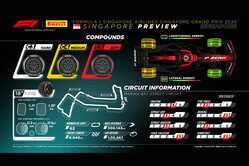


17/09/2024
NEWS STORY
 There are around seven thousand kilometres separating Baku and Singapore and the entire Formula 1 circus has just tackled yet another logistical challenge of this very long season, moving personnel, cars and equipment in a matter of a couple of days from the shores of the Caspian Sea to the city-state where the Malacca Straights meet the South China Sea. This is the first time these two races have been run back-to-back.
There are around seven thousand kilometres separating Baku and Singapore and the entire Formula 1 circus has just tackled yet another logistical challenge of this very long season, moving personnel, cars and equipment in a matter of a couple of days from the shores of the Caspian Sea to the city-state where the Malacca Straights meet the South China Sea. This is the first time these two races have been run back-to-back.
Here on the Equator, the dry weather compounds chosen for the 15th running of the Singapore Grand Prix are the same as last year's and in fact the same as at the past two races at Monza and Baku, on tracks each with very different characteristics: C3 as Hard, C4 as Medium and C5 as Soft.
The circuit was modified last year with the aim of making it flow better, but it is still one of the twistiest of the season. Its length is now down to 4.940 kilometres so that the number of laps has been increased to 62. In the final sector, between what used to include turns 16 to 19, a 400 metre straight has replaced them so that the number of corners has been reduced from 23 to 19. Last year, the work of resurfacing the track began and this year the sections between turns 3 and 9, 10 and 12 and 14 and 17 have also been resurfaced. The bitumen should be similar to that used on public roads generally open to city traffic, but with new asphalt one can expect a smoother surface. One does not usually learn much from the first free practice session, but this time it will give everyone the opportunity to acquire important data relating to tyre behaviour.
As with all street circuits, the slightest mistake in Singapore comes at a high price, given there are very few run-off areas and running a fraction off-line can see you in the barriers. Therefore the Safety Car is a common sight here, especially as it takes quite a while to remove a stricken car from the track. There are a couple of factors that make the one-stop the only valid strategy: firstly, the time lost for a tyre change pit stop is around 28 seconds, partly because the pit lane speed limit is reduced to 60 km/h and secondly, overtaking on this track is definitely complicated. A two-stop need only be considered in the event of the race being neutralised.
Usually, the Soft is purely a qualifying tyre, with the race laps split between the Medium and the Hard. However, last year the C5 played its part on Sunday, especially in the first stint with drivers wanting to make the most of its extra grip at the start. Degradation at this track is mainly down to thermal stress, not so much on the surface of the tyre, but within it, something one does not see that often and that varies a lot depending on car set-up and the aerodynamic load the cars generate.
At the Marina Bay circuit we have often seen first stints where the drivers are trying to go as long as they can, managing their tyres with the aim of balancing the two stints as much as possible. This often leads to the formation of a train of cars, all running nose to tail, unable to overtake because there is not enough of a performance difference, this despite the track having three DRS zones. Therefore, in an effort to produce more on-track action, the FIA has decided to introduce a fourth DRS zone for this weekend, between turns 14 and 16 and we will have to wait until Sunday to see if it produces the desired result.
Adding to the unpredictable nature of this race is the weather. Sitting astride the Equator, Singapore's climate does not vary, with high humidity, rarely below 70%, with the chance of rain showers, some very heavy, at any time of the day or night.
This was the first ever Grand Prix to be run at night under floodlights and, visually, it has always provided a great show. As usual on a tight track, qualifying is almost the most important factor when it comes to the race result, which explains why nine of the 14 races held to date have been won from pole position. The King of Singapore is Sebastian Vettel, who won here five times, on four occasions from pole, while his total podium tally is eight. With the German quitting the sport in 2022, he could lose his crown to Lewis Hamilton who has the same number of poles and four wins to date, while he is also closing in on the German's record for top three finishes, with seven.
Three other drivers still racing have also won at Marina Bay: Fernando Alonso has done so twice and Carlos Sainz and Sergio Perez have one victory apiece, while another retiree, Nico Rosberg also won here once. Of the teams, Ferrari, Red Bull and Mercedes lead the way, level on four wins, while Ferrari has the lion's share of pole positions with seven to its name. As for podium places, it's the blue of Red Bull that leads the way with 14 top three finishes.